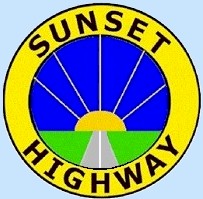
The Historic Sunset Highway
in Washington
Fall City to North Bend

The Historic Sunset Highway
in Washington
Fall City to North Bend
The first settlement on the prairie above the falls was in the spring of 1858, when the Kellogg brothers came and staked claims. During the summer of 1858, Jeremiah Borst arrived and staked a claim. He lived in the abandoned Fort Alder blockhouse until he could build his cabin. It would only take a few more years before about 2 dozen or so more settlers would call the area between Issaquah and North Bend as their home.
These first settlers all shared the common problem of having no road to Seattle. It was so hard to move anywhere beyond their homes, the early settlers in this area didn’t really communicate much with each other or the outside world.
The only way to get to Snoqualmie Falls, was to travel by canoe or steamer. This route followed the shoreline of Puget Sound northward to Everett. From here it was eastward up the Snohomish River to the town of Snohomish.
In the 1850's, the first tourists took canoes from Olympia to Snohomish and then up the Snoqualmie River to the "Landing" that is now Fall City and then take the trail up the hill to the falls. The only other way to reach Snoqualmie from Seattle was to take the Na-qui-a-ka Trail that the Snoqualmie People used to get to Puget Sound. The trail had ran between Renton and Fall City for hundreds of years and eventually became the Snoqualmie Wagon Road
When the Snoqualmie Wagon Road was completed in 1867, travel to Snoqualmie was still very difficult. The new wagon road was primarily used by cattle ranchers driving in herds from eastern Washington and miners going east to the gold fields of the Okanogan and Canada. There were very few people living in the Snoqualmie Valley that by 1870, only 50 people had made homes there. More people began to settle in the Snoqualmie area in the 1880's and the place became known as Snoqualmie Falls. On June 7, 1889, the town of Snoqualmie Falls was incorporated and in later years the "falls" was dropped from the name.
The Seattle Lakeshore & Eastern railroad came through Snoqualmie in 1889 on it's way to North Bend. This helped the town grow as more tourists and settlers came to town. In 1900, the Northern Pacific purchased the SL & E line and built a large depot in Snoqualmie for the many tourists visiting the falls. By the turn of the century, there were 430 people living in the town of Snoqualmie.
In 1917 the Snoqualmie Lumber Company built a large mill near the town that employed many people. The company later became the Weyerhauser Company and the Snoqualmie Mill lasted until 1989.
In 1929, a new Sunset Highway was completed between Snoqualmie and North Bend. This road is today a section of Highway 202.
In 1940, the town of Snoqualmie was bypassed by the new "Echo Lake Cutoff" and traffic through town slowed. Today Snoqualmie is a part of the suburban eastside with many of it's residents commenting to work each day on Interstate 90. The Snoqualmie Falls park continues to greet the many visitors who come each year to view the falls. the Snoqualmie Valley Railroad Museum is another tourist attract and in the summer months they offer train rides on their 7 miles of right of way.